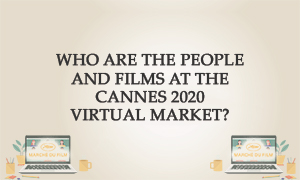
Today is the first full day of the 2020 Cannes Marché du Film. I’ve written a lot in the past about how Cannes works and how to get the best out of it. And all that’s useless. Well, for 2020, at least.
That’s because the COVID-19 pandemic has forced Cannes to move online and offer an online-only version of the annual film market.
I thought it would be interesting to take a look at the people who are “attending” and the films being “exhibited”.
A no-Cannes do

Cannes is the world’s oldest and largest film market, which normally takes place in the small southern French town of Cannes in mid-May. Since 1959, film professionals from around the world come together to network, plan future projects and buy/sell the rights to distribute new films. It has been its role as the industry’s pre-eminent meeting point which has ensured its longevity. Before the modern age, it was extremely hard to network remotely and almost impossible to see new, undistributed films.
While new technology has fixed these issues (i.e. video conferencing and 4k secure streaming), the experience of being together in a small town, the appeal of theatre screenings and the efficiency of a frenetic week of networking have meant that Cannes has gone from strength to strength. The 2019 Cannes Marché du Film was the largest to date.
But Coronavirus has changed everything. Given that Cannes’ strongest aspect was it physical nature, the need to move to online-only presented some serious challenges. This may have been a contributing factor to why the Cannes management were one of the last major events to acknowledge that the pandemic would halt their 2020 plans. Since then they have been working furiously to update their event for the 21st century.
Here are some of the key differences between Cannes as know it and the new incarnation:
- Cheaper to attend – Market passes cost €195 (€95 if you signed before 13th June) whereas the 2019 Marché cost €319 for the Early Bird and €433 for On The Spot.
- Shorter – Cannes is usually spread over ten days, whereas the new Marché will be over in half that.
- App-based networking– The film business is truly a global market and the Cannes Marché has traditionally been the main place to make new contacts and strengthen existing ones. To achieve this during lockdown, Cannes 2020 features virtual video meetings, ‘Speed Meetings‘ and a ‘Match&Meet‘ app.
- Conference events remain – The 2020 edition features the usual mix of interviews, panel discussions and talks, run by a number of differnt organisations and delivered via video streaming.
- Screenings move online – New, undistributed films are still being screened to buyers, although this is now through the markets’ site and app. More on this below.
- No parties – A major part of the Cannes experience is the parties. Unsurprisingly, this is absent, partly because the main appeal of this scene is its physical, exclusive nature and also because everyone has been heavily drinking remotely since March.
Who’s attending the 2020 Cannes Marché du Film?
At the time of writing, the market’s official website lists 9,520 delegates, although this is likely to rise with last-minute sign-ups. The 2019 market had their highest ever attendance, with 12,527 participants, meaning that this year’s “attendance” is around three-quarters of the previous year. Added to the much lower ticket price, it’s fair to assume that income is down significantly for the marché organisers.
The 2020 Marché maintains its international audience, with no one country making up more than 14% of the audience.
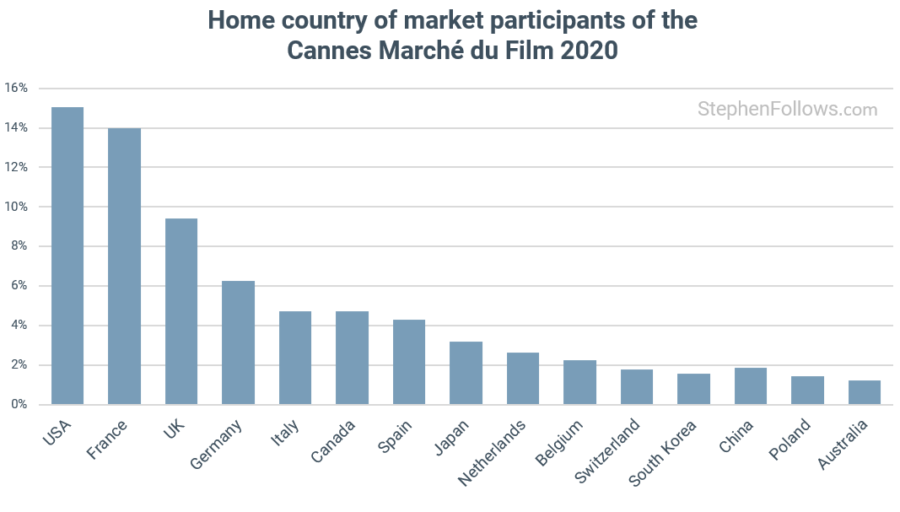
A couple of years ago, I conducted a study into the gender of film professionals at major film markets. I found that women were under-represented in senior jobs and over-represented in low-status jobs. The Cannes 2020 is no exception, with 40% of senior market participants being women.
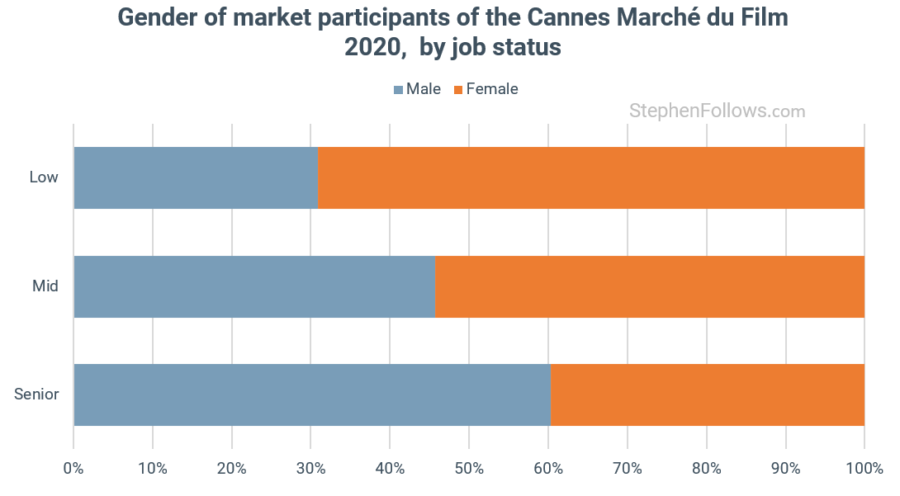
The good news is that these numbers continue the decade-long (albeit slow) trend of improvement in gender representation at Cannes. The percentage of people in senior roles who are women has risen from 30% in 2009 to 40% in 2020. Similarly, mid-level jobs have risen from 44% to 54% and low-levels jobs from 62% to 69%.
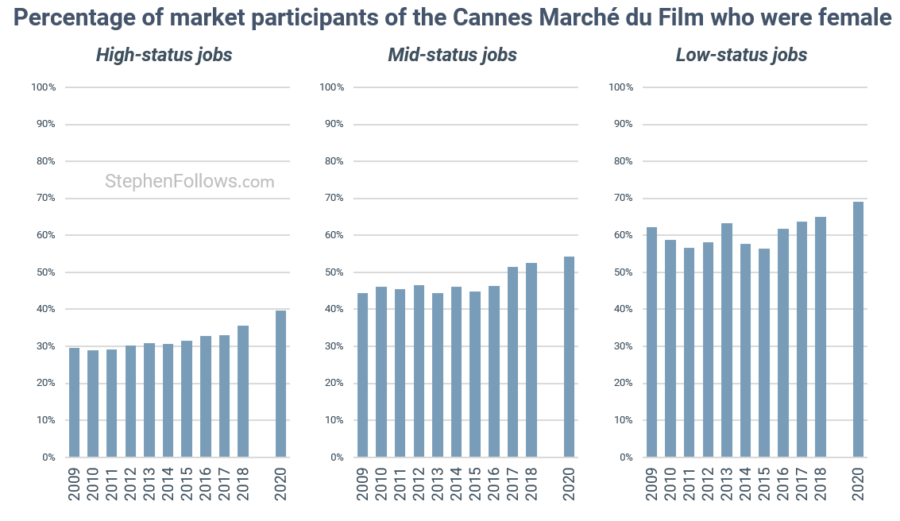
What kinds of movies are at the 2020 Marché du Film?
Films sold at film markets are not always ready for audiences immediately. At the 2020 Cannes Marche, three-quarters of movies are listed as finished, with 11.8% in post-production and about one in ten either shooting or still in development.

In past studies I have shown how drama is the principal genre for movies in the Cannes Festival, accounting for 93% of movies In Competition between 2010 and 2015. The market is far less drama-focussed, although drama is still the largest single genre (27% of movies on offer). The true figure may be slightly more as the Marché allows producers to select “Social issues” as a film’s primary genre. I would assume that almost all of these movies would also be classed as dramas (although, sadly, recent events suggest they could also be tense, action-packed thrillers).
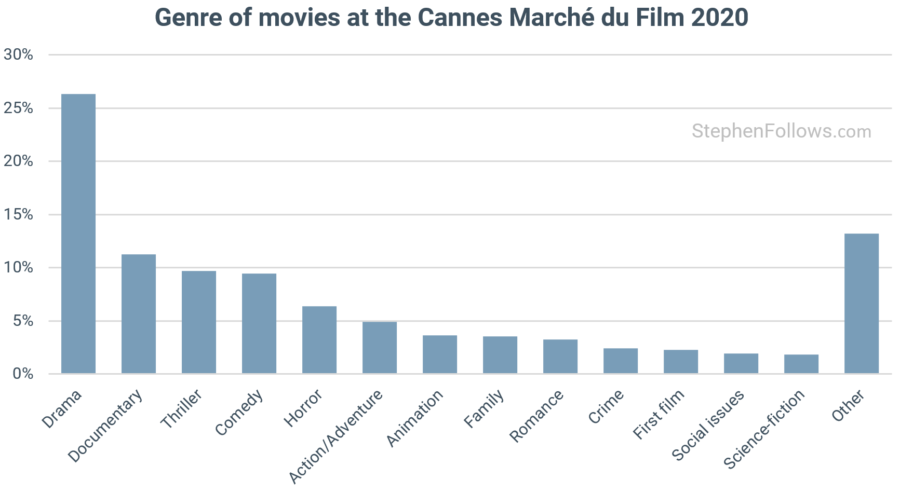
A fifth of movies at the market are American, although the binary system used in the market listing does not allow for multiple countries of origin.
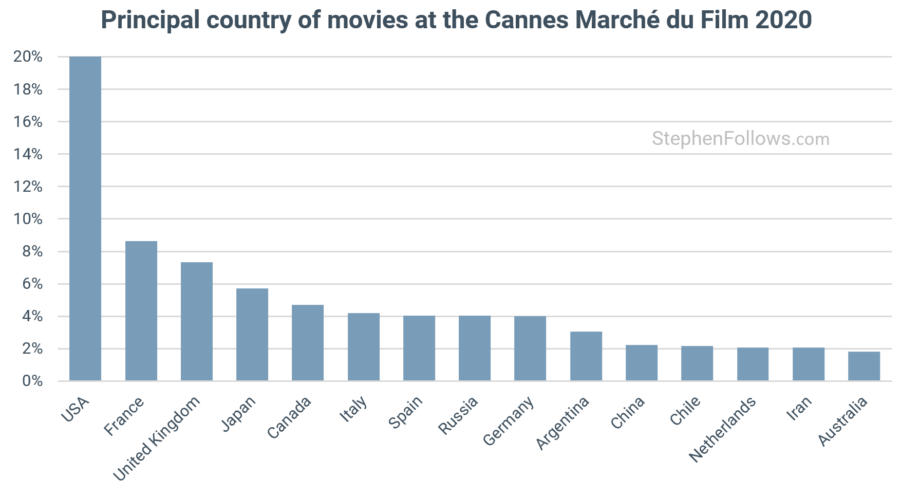
Almost half of all movies at Cannes 2020 are in the English language, Spanish and French being the second and third most popular languages respectively.
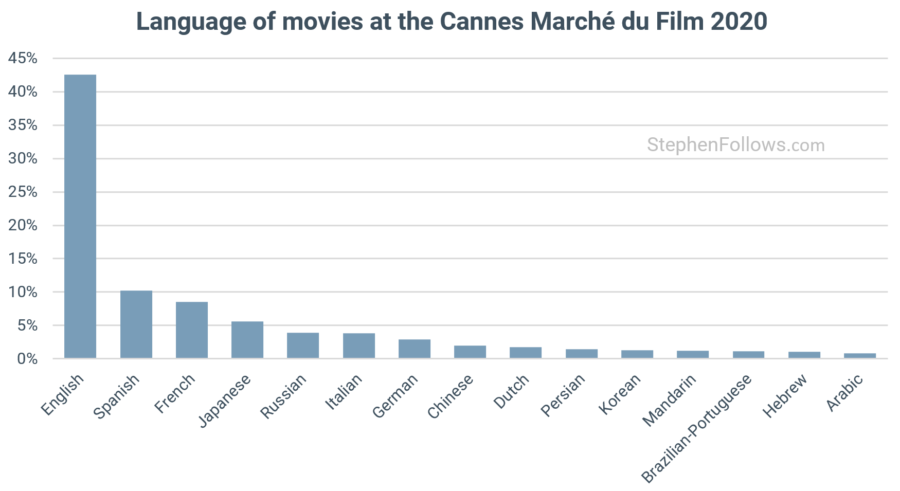
How do market screenings work at the 2020 Cannes Marché du Film?
A traditional market offers sales agents and filmmakers a very secure way of previewing their new films. Access to a market screening is regulated, there is high security to prevent piracy and the screening only takes place at a set time and place. This jars with the nature of online video, which is largely about constant, open and unregulated access.
To tackle this, the market organisers have developed an ingenious screening methodology. There are a set number of screening slots, named for the cinemas and screening rooms they would normally appear in (e.g. Riviera 3, Arcades, Olympia 15, etc).
The market traditionally lasts for ten days but the 2020 incarnation has crammed almost all screenings into a five-day period.
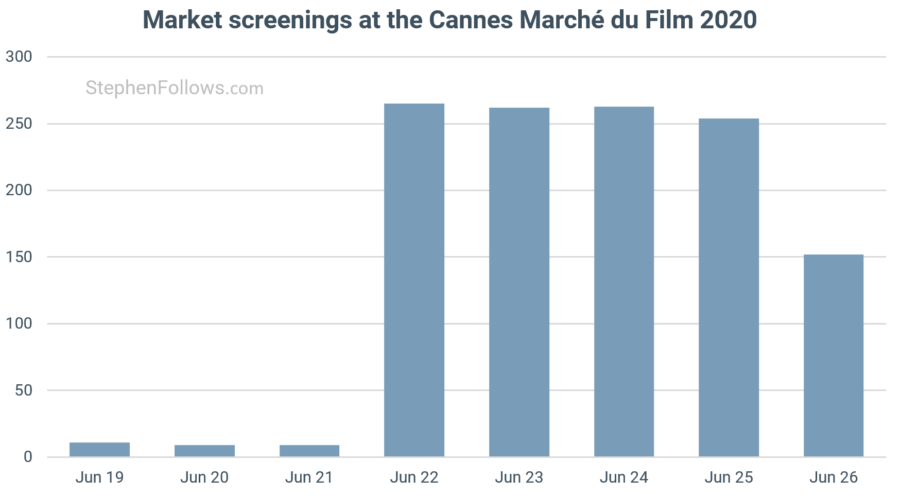
Screenings start at a fixed time and, so long as you have the right access and show up within an hour of the start time, users can stream the movie in question. If you turn up late, then you’ve missed the movie. To take account of international time differences, participants are required to pick an unchanging timezone for their account, and then the screenings are matched to that time. I.e. if a movie is screening at 9am then it will show at 9am local time for everyone.
Screenings are spread throughout a work day, with 97% of screenings starting between 9am and 6:30pm.
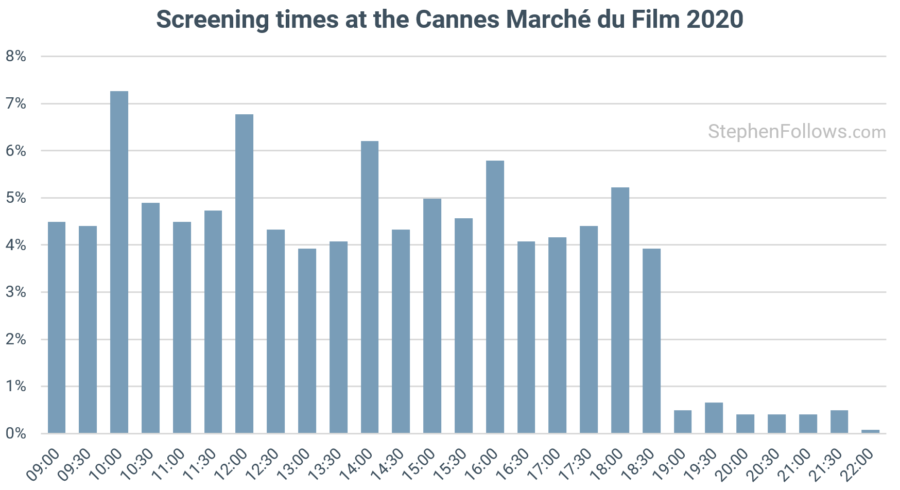
Notes
The raw data came from Cinando, the Marché’s offical listing site. I don’t have gender figures for Cannes 2019 as my previous study looked at the ten years between 2009 and 2018. Gender is not as binary as my graphs imply but I am yet to find a way to capture fluidity and change over time.
Epilogue
I am torn as to whether the 2020 Cannes Marché Du Film is a good model for future markets or not.
On the one hand, I like that the format massively increases access. The cost is a fraction of the usual bills for traveling, sleeping and eating in Cannes, and the format allows for better access for those with disabilities, children or commitments which inhibit travel.
On the other hand, the new format makes it much harder for new entrants to ‘get’ the film business. An hour walking down the Croisette and into the Palais could teach filmmakers more about the realities of the film industry than three years at film school (I know it did for me!) With an entirely virtual festival, fresh-faced attendees can’t know what they’re not being invited to, cannot witness the business taking place and the tools make it so much easier for people to be excluded across the board.
The virtual festival was a necessity for 2020. It will be interesting to see which features remain as the world starts to return to normal.

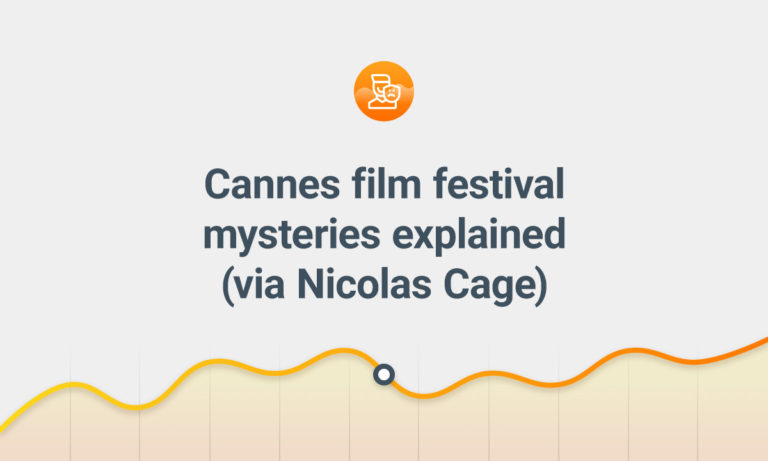
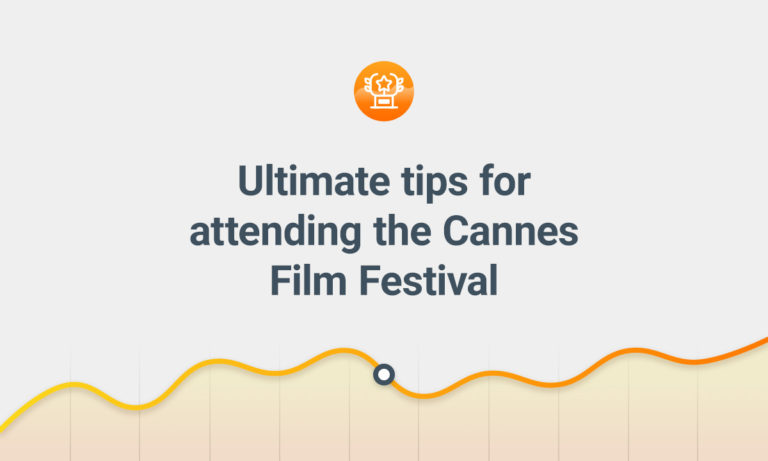
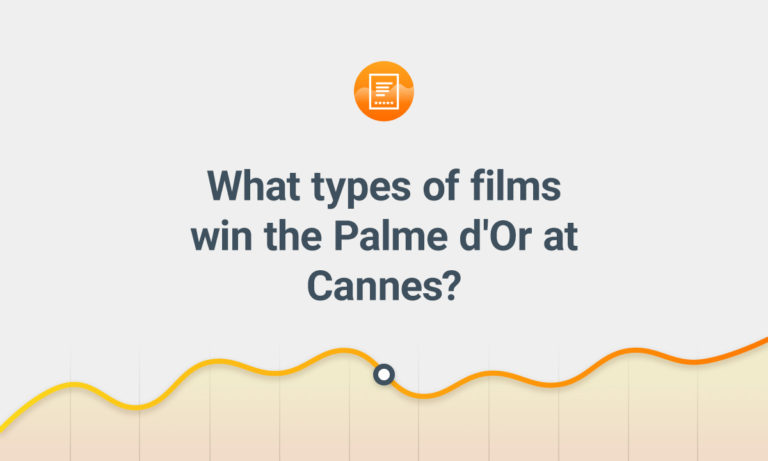

Comments
Thank you for taking the trouble to dissect this, as always. Having signed on as a Producer’s Network foot soldier, I’d support a more regular in-depth investigation of the Online Marche’s activities in how far this can provide insights where we are going and connections that get projects made.
Hi Stephen,
Great stuff! as ever. Thank you so much.
We are in attendance this year. I am not convinced this is the model moving forward. This virtual model puts another barrier between filmmaker and distribution and ultimately audience.
Thanks for all the info Stephen! We’ve passed on a lot of digital festivals this year and were feeling optimistic about the larger ones, even digitally. I was curious if you had any insight of submissions, is there less since production are pretty much halted? Or possibly more graphics/animation/post production projects making up for the difference?